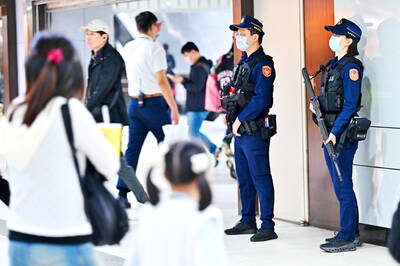There are about 11 billion barrels of oil and 190 trillion cubic feet of natural gas under the South China Sea, according to a US government report released on Thursday.
The reported oil reserves are higher than the proven oil reserves of Mexico, Angola and Azerbaijan, slightly less than the proven 14.8 billion barrels of oil in China and about half of the US’ proven oil reserves of 20.6 billion barrels, according to the CIA’s World Factbook.
The numbers — based on estimates by the US Energy Information Administration (EIA) — are significantly higher than the previously issued private US estimates of 2.5 billion barrels of oil.
“It is difficult to determine the amount of oil and natural gas in the South China Sea because of under-exploration and territorial disputes,” the EIA report says.
The estimates include both proven and probable reserves, and the report says there may be additional hydrocarbons in underexplored areas.
In November, the Chinese National Offshore Oil Corp (中國海洋石油), estimated the area held about 125 billion barrels of oil and 500 trillion cubic feet of natural gas in undiscovered resources. US experts believe these figures to be far too high.
“Stretching from Singapore and the Strait of Malacca in the southwest to the Strait of Taiwan in the northeast, the South China Sea is one of the most important trade routes in the world,” the report says.
It notes that the area includes several hundred small islands, rocks and reefs, with the majority in the Paracel (Xisha Islands, 西沙群島) and Spratly (Nansha Islands, 南沙群島) island chains.
“Several of the countries bordering the sea declare ownership of the islands to claim the surrounding sea and its resources,” the report says.
The EIA estimates the region around the Spratly Islands to have virtually no proven or probable oil reserves.
However, the US Geological Survey estimates there could be 2.5 billion barrels of oil and 25.5 trillion cubic feet of natural gas in undiscovered resources.
According to the new report, evidence suggests that most of these resources are likely located in the contested Reed Bank (Lile Bank, 禮樂灘) at the northeast end of the Spratlys, which is claimed by Taiwan, China and the Philippines.
The Paracel Island territory does not have significant discovered conventional oil and gas fields and has no proven or probable reserves.
“EIA estimates the South China Sea to be more viable as a source of natural gas than as a source of oil,” the report says.
It says producers would have to construct expensive undersea pipelines to carry the gas to processing facilities.
Submarine valleys and strong currents also present formidable geological problems to effective deepwater gas infrastructure.
“The region is also prone to typhoons and tropical storms, precluding cheaper rigid drilling and production platforms,” the report says.
It says that Taiwan, like China, asserts “historic” sovereignty over all features drawn within the dashes originally shown on a map published by the Chinese Nationalist Party (KMT) government in 1947 — including the Spratly Islands, the Paracel Islands, the Pratas Islands (Dongsha Islands, 東沙群島) and the Scarborough Shoal (Huangyan Island, 黃岩島).

The US government has signed defense cooperation agreements with Japan and the Philippines to boost the deterrence capabilities of countries in the first island chain, a report by the National Security Bureau (NSB) showed. The main countries on the first island chain include the two nations and Taiwan. The bureau is to present the report at a meeting of the legislature’s Foreign Affairs and National Defense Committee tomorrow. The US military has deployed Typhon missile systems to Japan’s Yamaguchi Prefecture and Zambales province in the Philippines during their joint military exercises. It has also installed NMESIS anti-ship systems in Japan’s Okinawa

TRAGEDY STRIKES TAIPEI: The suspect died after falling off a building after he threw smoke grenades into Taipei Main Station and went on a killing spree in Zhongshan A 27-year-old suspect allegedly threw smoke grenades in Taipei Main Station and then proceeded to Zhongshan MRT Station in a random killing spree that resulted in the death of the suspect and two other civilians, and seven injured, including one in critical condition, as of press time last night. The suspect, identified as a man surnamed Chang Wen (張文), allegedly began the attack at Taipei Main Station, the Taipei Fire Department said, adding that it received a report at 5:24pm that smoke grenades had been thrown in the station. One man in his 50s was rushed to hospital after a cardiac arrest

PUBLIC SAFETY: The premier said that security would be tightened in transport hubs, while President Lai commended the public for their bravery The government is to deploy more police, including rapid response units, in crowded public areas to ensure a swift response to any threats, President William Lai (賴清德) said yesterday after a knife attack killed three people and injured 11 in Taipei the previous day. Lai made the remarks following a briefing by the National Police Agency on the progress of the investigation, saying that the attack underscored the importance of cooperation in public security between the central and local governments. The attack unfolded in the early evening on Friday around Taipei Main Station’s M7 exit and later near the Taipei MRT’s Zhongshan

ON ALERT: Taiwan’s partners would issue warnings if China attempted to use Interpol to target Taiwanese, and the global body has mechanisms to prevent it, an official said China has stationed two to four people specializing in Taiwan affairs at its embassies in several democratic countries to monitor and harass Taiwanese, actions that the host nations would not tolerate, National Security Bureau (NSB) Director-General Tsai Ming-yen (蔡明彥) said yesterday. Tsai made the comments at a meeting of the legislature’s Foreign Affairs and National Defense Committee, which asked him and Minister of National Defense Wellington Koo (顧立雄) to report on potential conflicts in the Taiwan Strait and military preparedness. Democratic Progressive Party (DPP) Legislator Michelle Lin (林楚茵) expressed concern that Beijing has posted personnel from China’s Taiwan Affairs Office to its